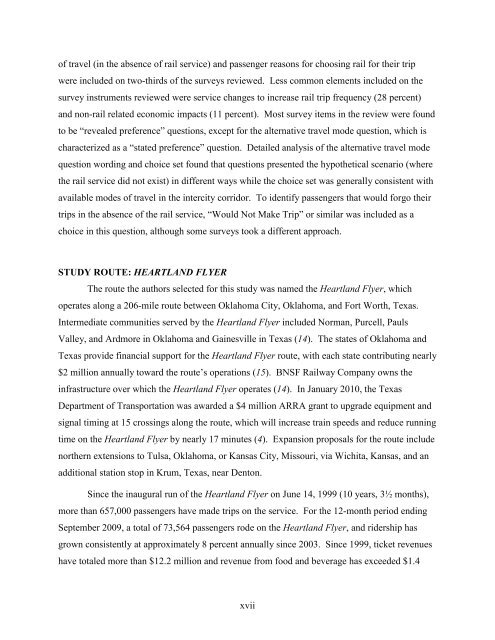Measuring the Benefits of Intercity Passenger Rail: A Study
Measuring the Benefits of Intercity Passenger Rail: A Study
Measuring the Benefits of Intercity Passenger Rail: A Study
Create successful ePaper yourself
Turn your PDF publications into a flip-book with our unique Google optimized e-Paper software.
<strong>of</strong> travel (in <strong>the</strong> absence <strong>of</strong> rail service) and passenger reasons for choosing rail for <strong>the</strong>ir trip<br />
were included on two-thirds <strong>of</strong> <strong>the</strong> surveys reviewed. Less common elements included on <strong>the</strong><br />
survey instruments reviewed were service changes to increase rail trip frequency (28 percent)<br />
and non-rail related economic impacts (11 percent). Most survey items in <strong>the</strong> review were found<br />
to be “revealed preference” questions, except for <strong>the</strong> alternative travel mode question, which is<br />
characterized as a “stated preference” question. Detailed analysis <strong>of</strong> <strong>the</strong> alternative travel mode<br />
question wording and choice set found that questions presented <strong>the</strong> hypo<strong>the</strong>tical scenario (where<br />
<strong>the</strong> rail service did not exist) in different ways while <strong>the</strong> choice set was generally consistent with<br />
available modes <strong>of</strong> travel in <strong>the</strong> intercity corridor. To identify passengers that would forgo <strong>the</strong>ir<br />
trips in <strong>the</strong> absence <strong>of</strong> <strong>the</strong> rail service, “Would Not Make Trip” or similar was included as a<br />
choice in this question, although some surveys took a different approach.<br />
STUDY ROUTE: HEARTLAND FLYER<br />
The route <strong>the</strong> authors selected for this study was named <strong>the</strong> Heartland Flyer, which<br />
operates along a 206-mile route between Oklahoma City, Oklahoma, and Fort Worth, Texas.<br />
Intermediate communities served by <strong>the</strong> Heartland Flyer included Norman, Purcell, Pauls<br />
Valley, and Ardmore in Oklahoma and Gainesville in Texas (14). The states <strong>of</strong> Oklahoma and<br />
Texas provide financial support for <strong>the</strong> Heartland Flyer route, with each state contributing nearly<br />
$2 million annually toward <strong>the</strong> route’s operations (15). BNSF <strong>Rail</strong>way Company owns <strong>the</strong><br />
infrastructure over which <strong>the</strong> Heartland Flyer operates (14). In January 2010, <strong>the</strong> Texas<br />
Department <strong>of</strong> Transportation was awarded a $4 million ARRA grant to upgrade equipment and<br />
signal timing at 15 crossings along <strong>the</strong> route, which will increase train speeds and reduce running<br />
time on <strong>the</strong> Heartland Flyer by nearly 17 minutes (4). Expansion proposals for <strong>the</strong> route include<br />
nor<strong>the</strong>rn extensions to Tulsa, Oklahoma, or Kansas City, Missouri, via Wichita, Kansas, and an<br />
additional station stop in Krum, Texas, near Denton.<br />
Since <strong>the</strong> inaugural run <strong>of</strong> <strong>the</strong> Heartland Flyer on June 14, 1999 (10 years, 3½ months),<br />
more than 657,000 passengers have made trips on <strong>the</strong> service. For <strong>the</strong> 12-month period ending<br />
September 2009, a total <strong>of</strong> 73,564 passengers rode on <strong>the</strong> Heartland Flyer, and ridership has<br />
grown consistently at approximately 8 percent annually since 2003. Since 1999, ticket revenues<br />
have totaled more than $12.2 million and revenue from food and beverage has exceeded $1.4<br />
xvii
















